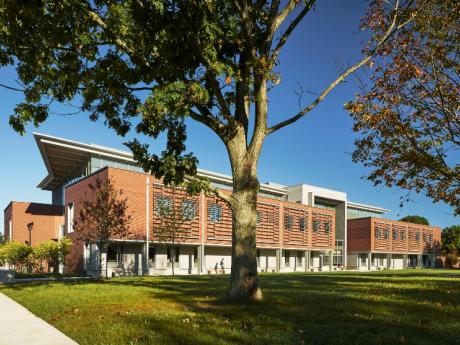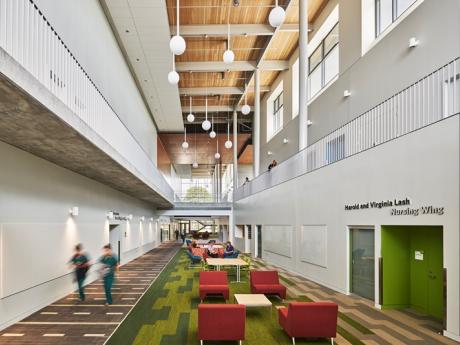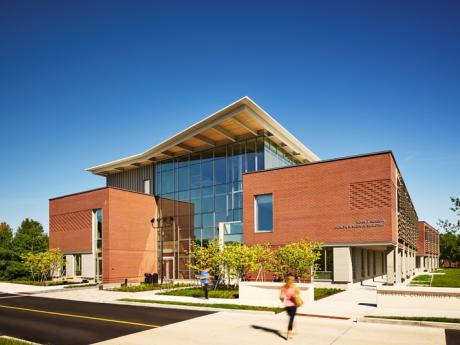John J. Sbrega Health and Science Building
Project Photo Gallery
Project Team
Other Team Members
Steve Kenyon, Bristol Community College, VP for Finance and Administration
Leo Racine, Director of Capital Projects
Barry Heidke, Division of Capital Asset Management and Maintenance, Project Manager
Jeff Freitas, Division of Capital Asset Management and Maintenance, Project Engineer
Fiske Crowell, FAIA, Sasaki, Architect
James Moses, AIA, Sasaki, Architect
Anthony Petone, PE, BR+A, Mechanical Engineer
Predrag Ciric, PE, BR+A, Electrical Engineer
Jacob Knowles, BR+A, Director of Sustainability
Paul Ormond, Haley and Aldrich, Geothermal Engineer
Nicole Holmes, Nitsch Engineering, Civil Engineer
Ian Scherling, Sasaki, Landscape Architect
Kenneth Johnson, Bond Brothers, Construction Manager
Steve Liechti, Bond Brothers, Construction Manager
Ratings, Awards and Recognition
The John J. Sbrega Health and Science Building is a shared resource occupied by multiple disciplines within the Sciences and Health Professions disciplines at Bristol Community College. The facility represents the translation of basic science to its application in the health professions. For the sciences, the building accommodates flexible instructional labs and support space for field biology, biotech, microbiology, and general chemistry. The health professions are represented by nursing skills and simulation labs, clinical laboratory science and medical assisting labs, dental hygiene labs and teaching clinic, which provides care to underserved populations.
These spaces are organized around a common, light-filled learning commons and student living room, meant to invite a broader set of users to the building as a place to study and otherwise learn in more informal ways. The walls separating lab spaces from the atrium are glazed, with a combination of opaque markerboard glass and clear glass, allowing for views into the labs and putting science on display.
The 50,600 square foot building serves traditionally energy-dense uses, including a large number of fume hoods, high plug loads, and specific ventilation and lighting requirements. An initial basis of design called for a high-performance building with numerous energy-conservation measures in order to meet the requirement that state-owned buildings be Massachusetts LEED Silver Plus, including a minimum of 20% energy cost-reduction relative to code.
While the project paused for funding in 2012, the College intensified its ACUPCC commitment to carbon neutrality by 2050, initiating plans to build a site-based 3.2 megawatt solar array. This new context presented an opportunity to reassess the original "high-performance" design, which, according to the energy model, would not keep pace with BCC's 2050 commitment, using at least 50% of the power generated by the solar array and enough natural gas to heat two hundred homes. The team made a strategic investment to develop a Zero Net Energy (ZNE) design, which would balance annual energy consumption with renewable energy generated on site. With few comparable built examples, the question was: how to achieve ZNE for an energy-dense program in a cold climate?
A number of options were tested using simulations, calculations, research, and discussions with manufacturers of advanced building technologies. Ultimately, a holistic combination of technologies and strategies were developed, including dramatically reduced lighting and plug loads, a high-performance envelope, natural ventilation systems, wider indoor temperature range, localized cooling, filtration fume hoods, air quality sensing, reduced air changes, enthalpy wheel heat recovery, and a hybrid-source heat pump system. Enhanced monitoring and verification will help to ensure efficient ongoing operation. The resultant design is projected to use less than 20% of the new array and no fossil fuels for heating and cooling. Significantly, the ZNE design was achieved without increasing the budget, serving as an important benchmark for future campus development and a model for other institutions.
Quick Facts
General
| Location | Fall River, Massachusetts |
|---|---|
| Building Type | College instructional laboratory building |
| Project Type | Zero Energy |
| Basis of Performance Claim | Modeled |
| Bathrooms | 6.0 |
| Conditioned Floor Area | 34,560 sq ft |
| Total Cost of Project | $36,900,000 |
Energy Summary
| Energy Data Type | Modeled |
|---|---|
| Renewable Energy System Type(s) | Photovoltaics, Geothermal, Other |
| Ratings | |
| Annual renewable energy generated | 900,000 kWh/year |
Envelope and Mechanicals
| Subslab assembly |
Slab on grade - 6" th. |
|---|---|
| Foundation wall assembly |
Foundation wall is essentially a frost wall. There is no basement. It is not insulated. |
| Above grade wall assembly |
Cladding (brick, wood, metal panel) |
| Door Assembly |
Aluminum |



